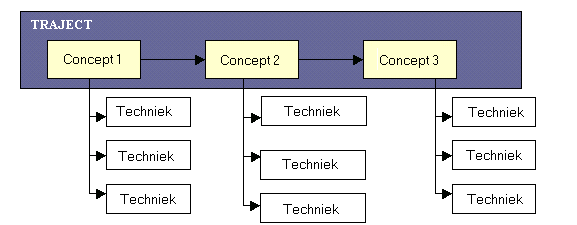Outputparameters
Output parameters
The figure below provides a schematic overview of the relationship between the basic elements 'route'/’pathways’, 'concept'/'step', 'technique' and 'design'.

Route
There are two possible routes/pathways in WASS:
1. biological treatment;
2. physicochemical treatment.
The choice of one of the two routes depends on the answer to the question if there is biodegradable organic material that must be removed.
A route consists of a sequence of different concepts.
Concept or step
A concept / step is a task that must or can be fulfilled by the water treatment system under design. A concept or step can be realized by different techniques (‘OR’ relationship). A technique may also be used in various concepts. Depending on the input parameters one to tens of concepts will be needed for one route. In total there are 21 concepts embodied in WASS:
1. Removal of coarse dirt;
2. Remove of sand;
3. Emulsion breaking;
4. Oil and grease separation;
5. Flow or composition buffering;
6. Cooling;
7. Neutralization;
8. Detoxification (pre- and post-treatment);
9. Coagulation and flocculation (pre- and post-treatment);
10. Precipitation (pre- and post-treatment);
11. Removal of floatable or settleable substances (pre- and post-treatment);
12. Devolatization;
13. Oxidation (pre- and post-treatment);
14. PACT system;
15. Biological pretreatment;
16. Biological main treatment;
17. Filtration;
18. Adsorption;
19. Non-selective removal of ions and organic substances;
20. Disinfection;
21. Selective removal of ions (pretreatment).
Note that the software does not consider the cleaning effect of any simultaneously selected upstream and / or downstream concepts when testing and selecting concepts. The system can for example suggest a particular treatment technology as a pre- and post-treatment, while a pretreatment alone can provide sufficient treatment. The output may also contain different concepts which are aimed at the removal of a single pollutant, with a similar treatment result. It is then up to the user to determine which configuration is best suited for the specific circumstances.
Technique and design
A technique is a unit operation. Since for some operations in the water treatment system, a large number of alternative embodiments are possible, a level of design was inserted. In total there are 42 techniques and 63 designs.

